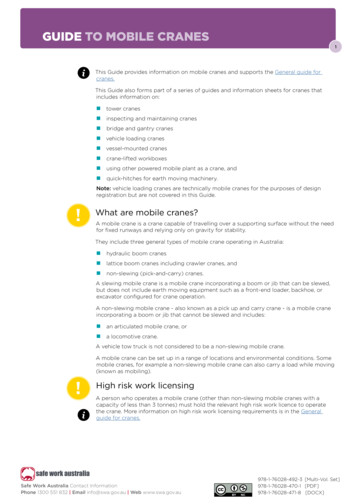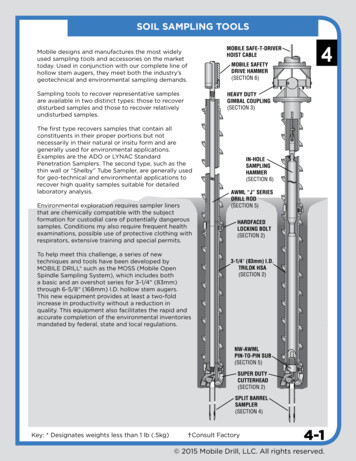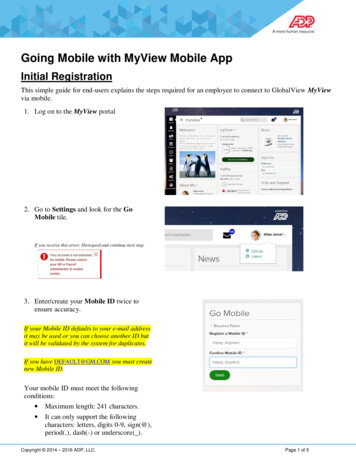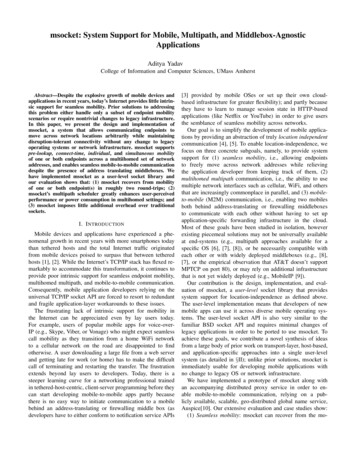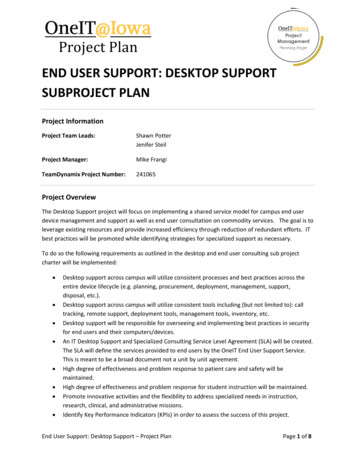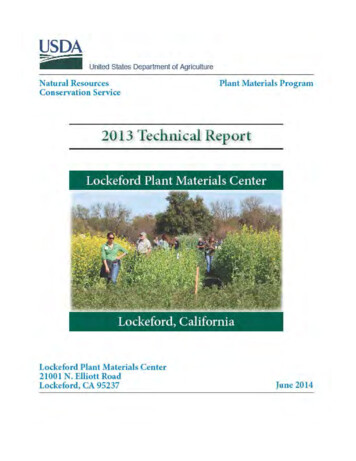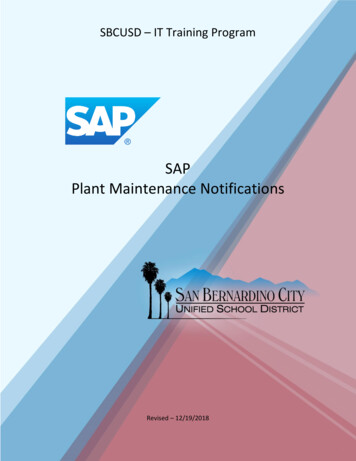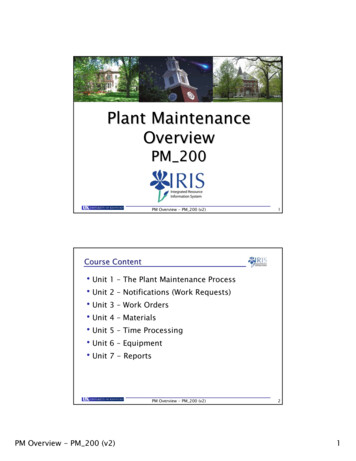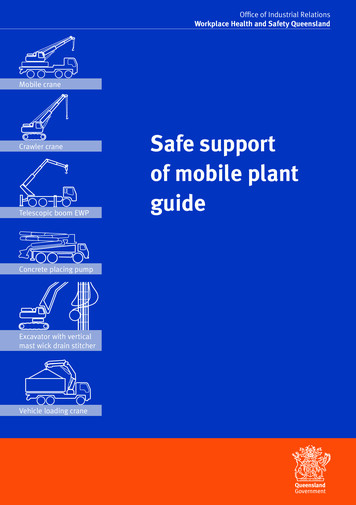
Transcription
Office of Industrial RelationsWorkplace Health and Safety QueenslandMobile craneCrawler craneTelescopic boom EWPConcrete placing pumpExcavator with verticalmast wick drain stitcherVehicle loading craneSafe supportof mobile plantguide
ContentsIntroduction. 1Issues. 1Types of mobile plant. 2Hazards and associated risks. 2Ground conditions . 2Proximity to excavations and trenches. 3Short legging of outriggers. 4Risk management. 4Planning. 4Pre-start work. 6Duration of works. 7Training and supervision.7Further Information. 9Legislation and codes of practice . . 9Australian Standards. 9Safe Work Australia. 9Safety alerts. 9worksafe.qld.gov.au1300 362 128 The State of Queensland 2018.This material is licensed by the State of Queensland under a Creative Commons Attribution 4.0 (CC BY) licence.To view a copy of this licence, visit: https://creativecommons.org/licenses/by/4.0. You are free to use this materialin line with the licence terms. You must keep the copyright notice on the copyright material and attribute the Stateof Queensland as the source of the copyright material. PN12316
IntroductionThis guide provides industry with methods to ensure that ground conditions have beensuitably assessed and that risks associated with plant overturning have been managedwhen operating mobile plant. Assessment should include management of groundconditions prior to the start of operations and ensuring outriggers are set up correctly.Mobile plant includes: elevating work platforms (EWPs) mobile cranes:–hydraulic slewing cranes–lattice boom cranes–hydraulic pick-and-carry cranes–vehicle loading cranes mobile concrete placing booms piling rigs any other mobile plant where the risk of overturning may be high.Ensuring there is adequate ground stability to support the load is a fundamental step inplanning for mobile plant use. Procedures for ensuring that plant does not collapse intothe ground or tip over are well documented in manufacturers’ instructions. Plant operatorsmay find additional information contained in industry best practice guides, codes ofpractice and Australian standards for mobile cranes or concrete pumps.IssuesPast incidents in Queensland include two fatalities involving the collapse of heavy mobileplant, where the primary cause was the subsidence of the ground beneath the mobileplant.In 2012, a worker was killed after being struck by the vertical mast mounted on anexcavator when the ground gave way, causing the unit to topple over.In 2015, a photographer was killed after the EWP he was working from collapsed when oneof the outrigger legs sunk into the ground.Plant stability is reliant on many factors including: the stabilising moment of the plant applied moments from any load ground conditions ground slope wind.Safe support of mobile plant guide1
Types of mobile plantMany models of EWPs, mobile cranes, concrete placing booms and telehandlers rely onthe safe support of outrigger feet to prevent the plant overturning. Crawler cranes andexcavators sometimes apply less pressure to the ground due to their track width andgreater surface contact area with the ground.Hazards and associated risksGround conditionsGround conditions can vary dramatically from one workplace to another and from one partof the workplace to another.Failure to address poor ground conditions to ensure mobile plant stability can lead to theplant overturning, with serious injury or death to the plant operator and others nearby.Factors that affect the ability of the ground to provide adequate support include: the presence of water, including when it is mixed with the soil as mud and when it isunder the surface (e.g. underground springs or streams) the type of ground (e.g. clay, sand, rock or a mixture of these) backfilled ground that was previously an excavation or trench cavities or penetrations in the ground that have been covered but still exist continued operation of the crane in one location rain, prior to and during operation of mobile plant including runoff that couldundermine dunnage, outrigger pads or bog mats.When mobile plant is being set up, the plant operator can only make a decision based onsite information available (e.g. diagrams for underground pipework, electrical conduitsand the surface of the ground).Generally, rock provides the most stable supporting surface for the mobile plant. However,although rock may be present on the surface, it may not extend far below the surface.One way to establish how far rock may extend below the surface is to examine nearbyexcavations or trenches at the workplace. Rock that extends far below the surfaceprovides a good indication of the ground’s integrity, as long as the excavation youare examining is not too far from the plant. Bear in mind that additional risks must bemanaged when outriggers are positioned too close to an excavation.Care must also be taken with ground that has a crust on its surface. The surface of thistype of ground is usually harder than the ground underneath (see photographs 1 and 2).The harder surface may give the perception that the ground is more stable than it actuallyis. If the ground is punctured by an outrigger, or the end of a crawler track, the softerground will be exposed, which may cause the plant to overturn.2Safe support of mobile plant guide
Be cautious when the ground is made up of fill. Indicators that the ground containsfill include the presence of rubble (i.e. broken concrete, bricks, metal, and timber) andthat the ground doesn’t appear to be natural. Do not assume that because there are noobvious signs that the ground is soft that it can safely support the plant.When mobile plant is continuously operated in one location the ground underneath theoutriggers will compact. Additional care must be taken to ensure that the plant has notcompacted the ground to the extent that the minimum overturning moment of the plant isreduced (i.e. the plant is more likely to overturn).Proximity to excavations and trenchesWhen mobile plant is set up close to excavations or trenches, there may be an increasedrisk of the sides of the excavation or trench wall collapsing, causing the crane to overturn.This risk increases with softer ground, and the presence of groundwater.The risk of collapse is greater for vertical cuts in the excavation wall in comparison to wallsthat have been battered back at an angle. The presence of ‘slippery back’, where there is anaturally occurring slip plain such as a fracture in the ground, can also increase the risk ofexcavation or trench collapse.Generally, the following principles should be applied when setting up mobile plant nearexcavations: Where the ground is compact and not crumbling, the distance of any part of the cranesupport timbers from the excavation should be at least equal to the depth of theexcavation (1:1 rule). For example, for a three-metre-deep trench in compact ground, the outrigger timbersor pads should be a horizontal distance of at least three metres away from the closestedge of the trench wall. Where the ground is loose or backfilled (i.e. crumbling), the distance of any part ofthe crane support timbers from the excavation should be at least twice the depth ofthe excavation (2:1 rule).Photograph 1: Outrigger pad onfill with no visual signs that theground is soft.Photograph 2: Outrigger pushedinto soft ground after breakingthrough crust.Photograph 3: Bog mat used to spreadthe applied load.Safe support of mobile plant guide3
Short legging of outriggersMobile plant may overturn when the boom or counterweight are positioned towards theshort-legged outrigger or stabilisers (see photograph 4).Short legging is a practice that is often carried out due to one or more of the following factors: Restrictive set up areas for the mobile plant (i.e. presence of underground servicesand obstructions such as barriers, roads, and structures). A risk assessment and preplanning of the job will significantly reduce the risk of mobile plant overturning. Unsuitable ground conditions for safe support of the outrigger feet (i.e. the ground issloping, uneven or too soft). The mobile plant operator has a poor understanding of the safe work practices.Operators and/or the person who conducts a business or undertaking (PCBUs) should notbe pressured into setting the mobile plant up unless it is safe to do so. The hirer and/orprincipal contractor also have a duty to ensure that the mobile plant can be safely set up.Photograph 4: Concrete placement boom overturned when the boom slewed overshort legged outriggers on one side of the vehicle.Risk managementWork health and safety laws require a PCBU to manage all work health and safetyrisks, so that the health and safety of workers and other people are not affected by anorganisation’s conduct.Risk management principles should be applied to the planning, pre-start and duration ofworks phases for the use of mobile plant at a workplace.Planning At the design and construction stages of the building, designers and specialistcontractors should consider that adequate space must be available so that mobileplant required as part of the building process, can be safely set up and packed up.4Safe support of mobile plant guide
Ensure an assessment of ground conditions has been made in relation to the:– ground support required for the mobile plant– expected applied load. Operators who make this assessment must be provided with suitable training,instruction and supervision to be deemed a competent person to make thisassessment. Where work is to be carried out as part of a construction project and/or where aprincipal contractor (PC) is appointed, it is the PC’s duty to ensure the workplace hasbeen adequately prepared for the incoming mobile plant. This would include ensuringthat a suitable assessment of the ground conditions has been carried out prior tothe start of works. Section 13.1 of the Mobile Crane Code of Practice 2006 providesdetailed information on the roles and responsibilities associated with mobile craneoperation on a worksite. This information applies across all forms of mobile plant. Ensure that a safe work method statement (SWMS) has been prepared that showsthe operating conditions under which the mobile plant can be used, including shortlegging. For concrete placement booms and truck mounted elevating work platforms,the SWMS is to include a diagram showing the permissible operating zone of theboom. For mobile cranes the load chart is to show lifting capacities of the crane withoutriggers, including when outriggers are only partially extended. This load chart is tobe complied with for all positions of the boom. Mobile plant owners should ensure that adequate timbers and/or pads are providedwith the plant when it leaves the yard so that it can be set up safely on the groundtype that exists on site. This may require sending another vehicle to site with theplant, if the additional timbers and pads cause the mass of the mobile plant toexceed allowable axle loadings specified by the relevant authority (i.e. Department ofTransport and Main Roads). If the ground is particularly poor the PC may need to havethe ground improved under the guidance of a geotechnical engineer. For operation of a mobile crane, following assessment of the ground conditions,the crane operator must select suitable support for the use of the outriggers. Thecrane operator must be competent to use calculation formulas provided by themanufacturer of the plant to determine the ground pressure that will be applied whenthe mobile plant is at maximum capacity. A reasonable approximation for maximumground pressure applied by the outriggers can be determined by using calculationsavailable in section 10.2.6 of the Mobile Crane Code of Practice 2006. Risk of plant overturning becomes greater as the size of the plant increases and/or the ground condition is poor. The best outcome is that a geotechnical engineerassesses the ground condition before the mobile plant is set up or travels overthe ground. Sometimes a geotechnical engineer is required as part of the buildingprocess to assess the ground. If this is the case, the geotechnical engineer should beengaged to make an assessment of the ground in the location where the mobile plantis to be set up and the bearing capacity of the ground is to be provided to both thesupplier of the mobile plant and the plant operator. Even if the geotechnical engineerassessment is not required as part of the building activity it is advisable to engage ageotechnical engineer wherever the bearing capacity of the ground is unsure. Furtherguidance on this topic is provided in t
the crane support timbers from the excavation should be at least twice the depth of the excavation (2:1 rule). Photograph 1: Outrigger pad on fill with no visual signs that the ground is soft. Photograph 2: Outrigger pushed into soft ground after breaking through crust. Photograph 3:


